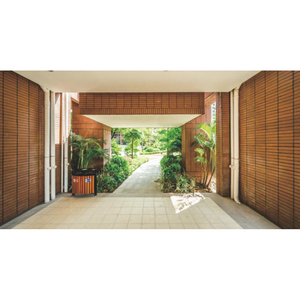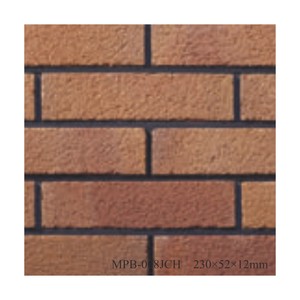
All categories
Featured selections
Trade Assurance
Buyer Central
Help Center
Get the app
Become a supplier

(1481 products available)







































A ceramic facade panel is a covering for building exteriors that consists of a core material and a ceramic layer. The ceramic layer is usually less than 6mm thick. These panels are also known as prefabricated ceramics for their ability to be manufactured and assembled in a factory. They are then installed on the building as finished products.
Ceramic facade panels come in different types and forms, as discussed below:
Panel with exposed concrete core
This type of ceramic facade panel has a core made of concrete that is clearly visible. The concrete gives the panel strength and stability. It is important for supporting the facade. The exposed concrete surface can be seen in the finished building. It has a rough, natural look. Even though the concrete is rough, it is still able to hold the ceramic layer. This layer is smooth and can be made in lots of different colors and patterns. The concrete core helps the panel stay rigid. It makes sure the facade does not sag or bend over time.
Panel with lightweight core
This type of ceramic facade panel has a core made of lightweight materials instead of heavy concrete. The core materials are usually made of honeycomb paper, foam, or plastic.
The lightweight core makes the panel much easier to lift and move. This speeds up the installation process and reduces the amount of work needed. Since the panel is lighter, it puts less stress on the building structure as well. This allows for larger panels to be used safely.
Solid panel
The ceramic facade panels are called solid panels because their core is also made from concrete. Unlike other panels, the concrete core of the solid panel is not hollow or lightweight. This makes the solid panel stronger and more durable.
Since the core is solid concrete, the panel facade does not bend or sag over time. It maintains a straight appearance. The solid panel provides better sound insulation too. The solid concrete core blocks out noise more effectively.
Honeycomb ceramic facade panel
This type of panel has a honeycomb structure made of cardboard. The honeycomb structure adds rigidity while keeping the panel light. The honeycomb core makes the panel's facade straight and stable. It prevents bending or sagging over time. The honeycomb core also reduces the overall weight of the panel. This allows for larger panels that are easier to install.
Ceramic facade panels, also known as ceramic facade tiles, curtain wall ceramic panels, or ceramic wall cladding panels, are materials used in building exteriors. They serve both functional and aesthetic purposes. Here are some features and functions of these panels.
Aesthetic appeal
The ceramic facade panels come in different sizes, shapes, and colors. This allows architects and designers to use them to make buildings that look nice. The panels' shiny surface reflects light, giving the buildings a glamorous look, especially at night.
Durability
Ceramic facade panels are made from materials that do not easily get damaged. They can withstand bad weather, hits, and scratches. Unlike other facade materials, these panels do not fade or show signs of wear over time. This keeps the buildings looking beautiful for many years.
Low maintenance
These facade panels are easy to clean. They just need a wash with soap and water to remove dirt. They do not absorb stains, so they maintain their color. The panels are also resistant to mold and mildew. This lowers the need for cleaning chemicals, which is good for the environment.
Versatility
Ceramic facade panels can be used on many kinds of buildings. These include homes, offices, hospitals, hotels, schools, and shopping centers. The panels can also be put on different building surfaces, such as walls, curved surfaces, and sloped roofs.
Insulation
Curtain wall ceramic facade panels help keep the inside of buildings at a comfortable temperature. Some types have special materials that stop heat and cold from going through. This insulation keeps buildings warm in winter and cool in summer. It also lowers the energy needed for heating and cooling.
Soundproofing
Ceramic facade panels help reduce noise inside buildings. Their thick walls stop sound from going through easily. This keeps homes and offices quiet, even when there is noise outside. It makes living and working spaces more peaceful.
Fire resistance
Ceramic facade panels are made from materials that do not burn easily. If a fire starts, these panels help slow the fire down and stop it from spreading quickly. This gives people more time to get out of the building safely. It protects the building and the people inside.
Ceramic facade panels are versatile materials used in various scenarios for both functional and aesthetic purposes. Here are some common usage scenarios:
Building Facades
Ceramic facade panels are widely used to cover the exterior walls of buildings. They provide protection against weather elements such as rain, wind, and debris. These panels also enhance the aesthetic appearance of buildings by offering different colors, textures, and designs. Additionally, they improve energy efficiency by reducing heat transfer and sunlight glare.
Commercial Construction
Ceramic facade panels are commonly used in commercial buildings such as office towers, hotels, and shopping malls. They create a modern and professional look in these structures. These panels are also designed to withstand high traffic and urban environments' harsh conditions.
High-Rise Buildings
Ceramic facade panels are suitable for high-rise buildings due to their lightweight nature. This helps to reduce the structural load on the building. Their durability also ensures they can withstand strong winds and extreme weather conditions. For example, in New York, ceramic facade panels are widely used in high-rise residential and commercial buildings.
Residential Homes
These panels are also used in residential buildings. They improve the aesthetic appearance of homes and provide long-lasting value. Additionally, ceramic facade panels are easy to maintain and offer resistance to fading, cracking, and moisture.
Architectural Cladding
Ceramic facade panels are used for architectural cladding in museums, cultural centers, and government buildings. They create unique and visually stunning designs that enhance the building's architectural features. These panels also provide cultural significance by incorporating traditional patterns and motifs. For instance, ceramic facade panels are used in cladding the exterior of architectural buildings in Washington.
Interior Walls
Ceramic facade panels are used to create accent walls in interior spaces. They add visual interest and depth to a room. These panels are also used in commercial spaces such as restaurants, hotels, and retail stores. They create a stylish and contemporary look in these spaces.
Consider the following when choosing the ideal ceramic facade panels for sale:
Panel Material, Durability and Maintenance:
First, consider the panel material. Some ceramic panels contain recycled materials, which are eco-friendly. If a project is focused on going green, it is important to choose facade panels that are partially made of recycled materials.
Facade panels differ in terms of how well they can withstand external conditions. Some are more durable than others. Ceramic panels are generally very durable, but some may have a longer lifespan than others. For example, porcelain facade panels are more long-lasting and robust compared to normal ceramic panels. Porcelain panels can be ideal for projects that require low maintenance panels that will last for many years.
Facade panels are simple to maintain. The ceramic panels only need to be washed with water and detergent to remove dirt and stains.
Panel Style, Design and Color
Consider the project or building style and theme. This will ensure that the ceramic facade panels complement the architectural design of the building. Pay attention to the ceramic facade panels style, texture, shape, size, and color.
When it comes to color, lighter panels make buildings look spacious and airy. On the other hand, darker panels conceal dirt and debris better than lighter-colored panels. The color of the facade panels should also match the color of the building.
Building Location and Orientation:
The location and orientation of the building play an important role in determining which ceramic facade panels are ideal. If the building is in a windy area, choose facade panels that can withstand strong winds. Buildings near the ocean or in windy areas may require ceramic panels with high strength and durability.
For buildings in hot and sunny areas, consider facade panels that can withstand UV rays and extreme weather conditions. These panels will protect the building from damage and ensure it lasts for many years.
Q1: Are ceramic facade panels eco-friendly?
A1: Yes, ceramic facade panels are eco-friendly. They are made from natural materials like clay, which is abundant and recyclable.
Q2: Do ceramic facade panels require special maintenance?
A2: No, ceramic facade panels do not need special maintenance. They only require regular cleaning to maintain their appearance.
Q3: Can ceramic facade panels be customized?
A3: Yes, ceramic facade panels can be customized. They can be made in different sizes, colors, and textures to suit specific design needs.
Q4: Are ceramic facade panels suitable for all climates?
A4: Yes, ceramic facade panels are suitable for all climates. They are durable and can withstand extreme weather conditions.
Q5: Do ceramic facade panels fade over time?
A5: No, ceramic facade panels do not fade over time. They are resistant to color change caused by UV rays.